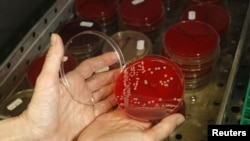A new study shows that bathing hospital rooms in ultraviolet light kills drug-resistant superbugs that put the health of patients at serious risk.
The UV light is emitted by a "robot" wheeled into a room before a patient checks in. A study by Duke University researchers in North Carolina found that ultraviolet C light, or UVC, switched on for a half-hour after the previous patient checked out can reduce the presence of drug-resistant bacteria by 30 percent.
The UVC light poses no risk to humans, unlike other types of ultraviolet light emitted by the sun that can cause skin cancer.
The 1.5-meter-tall, cylindrical UVC robots are used in what's called a terminal cleaning process. That's when hospital personnel scrub a room from floor to ceiling with chemical agents to try to eliminate all traces of bacteria that a sick patient may have left behind.
Drug-resistant superbugs, which can live on flat surfaces, are the most serious worry. Often-lethal microbes like MRSA, or methicillin-resistant Staphylococcus aeurus, do not respond to standard antibiotics, making it very hard to treat patients who become infected with them.
But Deverick Anderson, director of Duke's Center for Antimicrobial Stewardship and Infection Prevention, said UV light reflects off flat surfaces and "can really get into all the nooks and crannies of a hospital room."
The Duke study, published in the journal The Lancet, was conducted at nine hospitals. Researchers compared the effectiveness of using UVC along with different chemical agents or only a cleaning agent.
Fifteen to 20 percent of hospital rooms were cleaned using the UV robots. Anderson said the devices were used in rooms where it was suspected that superbugs lurked. These rooms included intensive care units and rooms where patients had been treated for drug-resistant bacterial infections.
The researchers found that the cleaning strategy of using the robot with a cleaning agent called quaternary ammonium worked best against MRSA.
The cleaning protocol was most successful with actively growing bacteria, including MRSA and vancomycin-resistant enterococci or VRE, and less so with those microbes that form dormant, protective spores, like the intestinal pathogen C. difficile.
The protocol "literally gets to the DNA, disrupts the DNA, and kills the bacteria," said Anderson.
Anderson said hospitals involved in the study are continuing to use the UVC robots, which cost about $90,000 each.
The next step, according to Anderson, is to see whether incorporating the devices into daily room cleaning, during a patient's hospital stay, does a better job of eliminating superbugs than using the robots after patients have checked out.









